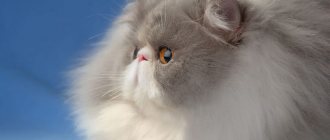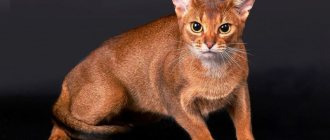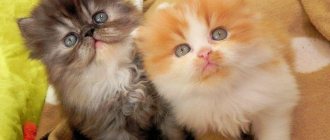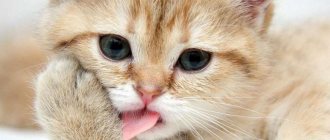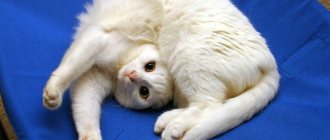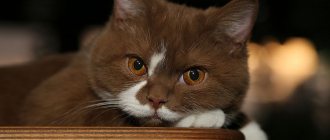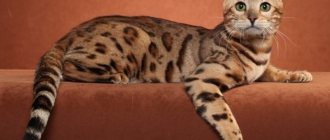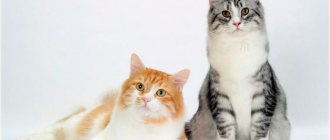Video
* We invite you to watch a video about the Persian cat . In fact, in front of you is a playlist in which you can select and watch any of 20 videos about a given cat breed by simply clicking on the button in the upper right corner of the window. In addition, the material contains quite a lot of photos. By looking at them you can find out what a Persian cat looks like.
In this article:
|
Rate the material!
[Total votes: 1 Average: 5]
The Persian cat is an ancient and complex breed with the face and habits of a languid, moon-faced beauty of the East. She makes the most mediocre sofa look chic while she sits on it. And after leaving, he leaves a pile of fur and regret for having such a beast. But the Persian can always correct the impression with just one glance and calm him down with affection and a measured hum.
Care and character of the breed
The Persian cat has established itself as a calm, even shy creature, not prone to intrigue and adventure. She is obedient and undemanding, affectionate and not at all aggressive unless teased. However, you shouldn’t leave her to her own devices: due to lack of attention to her person, the cat can become depressed and even die from melancholy. The character of Persian cats can be described in a few words: affectionate, unpretentious, sociable, quiet and obedient. And with such character qualities, they are also elegant, beautiful and restrained in English.
The main disadvantage of Persians, from the point of view of a busy person, is precisely their luxurious coat, which requires constant care. A cat's shedding lasts all year round, so a Persian cat (or rather, its fur) requires a lot of daily care.
Firstly, dead hair, if not removed, naturally ends up in the cat's stomach, where it forms dense clumps. Such a lump can block the stomach or intestinal tract, which may lead to surgery.
Secondly, hair that is not combed out in time forms tangles, the removal of which is a very painful procedure for a cat.
Caring for a Persian cat involves combing the coat daily with a wide-tooth comb and then thoroughly brushing it with a natural bristle brush. You need to comb not only the cat itself, but also the fur on its paws and between its toes.
Regular daily eye examinations will help you not to miss the onset of a disease such as blocked tear ducts. Unfortunately, Persians of all varieties and types are prone to this disease. It is strictly necessary to keep the eyes of Persian cats clean!
Many, wanting to have such a magnificent animal at home, strive to buy a kitten, without even thinking about how much work and care it will require and are not even curious about how to care for the baby. A baby Persian needs exactly the same daily care as an adult cat. And perhaps even more!
Before you decide to purchase such a delicate creature, weigh your options again and make the right decision. But, if you have enough time and patience, you can be sure that in the “face” of this cat you will get an excellent, loving and devoted feline companion for many years. The lifespan of Persian cats is on average 15 years, but there are cases where these cats lived much longer - up to 20. Such a kitten costs up to 30,000 rubles.
History of the origin of Persian cats
The history of this ancient breed is dark and unclear, since none of the historians bothered to record the initial stages of its formation. It is not even known whether the African wild cat, the ancestor of the domestic subspecies of cats, was in her family tree. In any case, African women do not have long hair.
The first documented evidence of the ancestors of Persians (Iranian cats, also known as Shiraz cats) reports that gray cats were brought to Italy in 1620 by Pietro della Valle from Khorasan (Iran), and white cats by Nicolas-Claude Fabry de Peyresse around the same time from Angora (Ankara, Turkey) to France. From France they came to England. Genetic studies prove that it was these imported individuals that became the founders of the breed, which has lost its direct connection with Persia.
After World War II, English and American breeders became the main breeders of modern Persians. The selection came from the variety of colors and shapes of the muzzle, which they tried to make as flat as possible. This led to the emergence of health problems and the spread of polycystic kidney disease - the main hereditary disease of Persians, especially in American peke-faced lines. In England they preferred to stick to the classic type of breed.
Interesting fact: Felinological organizations adhere to their own standards and different points of view on this breed. Some (FIFe, CFA, TICA) include the Himalayan and/or Exotic Shorthair breeds under the Persian variety, others separate them from the Persian (ACFA/CAA).
In 2015, Persians were recognized as the second most popular breed in the United States according to CFA felinologists. In recent years, they have become less in demand, but in the nominations of various societies for “best cat of the year,” their representatives remain consistently among the top 25. In Russia, the Persians also do not take prizes, but they are in the top ten. Extreme sports are especially popular.
Interesting Facts
- It is Persian cats that have the longest hair. None of the other breeds can compare with the Persians in this parameter. The record for the longest fur on a cat is 23 centimeters;
- The Persian is one of the oldest breeds known today. Its roots can be traced back to the 17th century;
- Persian cats were very popular among French aristocrats. In addition, it is believed that the British Queen Victoria was partial to this breed;
- For several years in a row (2010 - 2013), Persians ranked first in popularity among cats registered with the CFA;
- Persians, more often than other cats, are cut “like a lion”: the body and paws are shaved, leaving hair on the face, collar, socks and a tassel at the tip of the tail.
Clipped Persian cat
Persian cat - description of the breed
The model Persian cat is dense, big-boned, and has a pleasant rounded outline. A fluffy fur coat that wraps a cat makes it even more round, warm and affectionate. Big eyes make her attractive and pretty. Height up to 30 cm, weight: up to 7 kg (males) and up to 5 kg (females).
Most standards accept the following parameters:
- The head is massive, with a wide skull, sitting on a short neck. The muzzle is round, flattened, with thick cheeks and a round chin;
- The nose is wide and short, with a dent - a stop between the eyes;
- The small ears are rounded at the ends and set wide apart;
- The eyes are round, bright, large, widely spaced, and have a friendly expression;
- The body is massive, smooth along its entire length, like a roller, muscular;
- The legs are thick and short, but strong;
- The feet are round and large, like mittens, with five toes on the front feet and four on the hind feet;
- The tail is relatively short, the cat does not curl it, but carries it in flight, slightly lowered;
- The coat has a dense undercoat, protruding, very long and thick, thin. It forms a lush frill on the shoulders that goes down to the chest. The tail is especially fluffy, and there are tufts of fur on the ears and fingers.
Faults in a cat that lead to disqualification are:
- Medallion, that is, a white spot on the chest or neck, in the groin, under the armpits, if white is not characteristic of the general color type;
- Deformations of the back, skull, tail;
- Weakness of the hind legs;
- Strabismus.
Some systems recognize three types of rock.
This division is supported by many Persian lovers in our country:
- Classic (old-fashioned, doll, traditional longhair) has a relatively large and not very upturned nose, the distance between the lower eyelid and the upper edge of the nose is 5-6 mm;
- Modern - the nose is shorter and upturned, the lower eyelid is at the same level with the edge of the nose or 1-2 mm below it;
- Extreme (peke-faced - with the face of a Pekingese) - eyes at the same level as the nose.
Popular colors of Persian cats
The Persian breed leads in the number of colors, of which there are about 100. Even taking into account that not all felinological systems recognize white color and color point. The classification of colors depends on the system: each has its own.
For example, the CFA distinguishes:
- Plain (solid) - fur coats are painted in one color: from snow-white to coal-black. There are colors of lilac, chocolate, cream, red (red). White cats may have blue, copper, or different eyes;
- Chinchilla has very delicate, almost iridescent colors, due to the fact that each hair has a dark tip. There are silver and golden chinchillas, as well as combinations of these colors;
- Smoky and shaded – the undercoat and lower part of the guard hair are light, the upper part of the guard hair is dark. They can be black, blue, cream, cameo (light cream), red, blue-cream. The color looks good when the cat smoothly flows from place to place;
- Tabby - the coat has patterns in the form of dark patterns (marble), stripes or spots. Colors are brown, silver-black, blue, cream and others that are only found among Persians. Spotted tabbies are distinguished from tortoises by their small, mixed and often indistinct spots and can be called "pied";
- Calico (tri-color) combines white with red and black or cream and blue;
- Tortoiseshell - a combination of two contrasting colors (black and red, blue and cream, brown and cream, etc.) often in combination with white;
- Himalayan color, or color point - cats have a dark face, ears, limbs, tail, and a light body. There are numerous varieties of color depending on the color of the painted areas: seal point, red point, blue point, etc. And also depending on the pattern on the body, which can combine spots of one or two colors. Blue eyes.
Intrabreed varieties of Persian cats
The Persian has many intra-breed varieties, each of which corresponds to one of the five officially recognized FIFe and WCF categories:
- monochrome;
- partially painted;
- shaded;
- smoky tabbies;
- colored within the boundaries of points.
For each color there are certain criteria.
Black
The color of this variety of Persian breed is deep black without white hairs and gray undercoat. Any inclusions of a different shade are considered a fault. The hair is long, especially on the collar area and between the forelimbs. The undercoat is thick.
The body of the black “Persian” is stocky and strong. The paws are short, framed by abundant vegetation, and have black or brown pads. The tail is medium in size and fluffy. Eye color: orange or copper. The nose is snub-nosed and small in size. The mustache is long.
The color of the coat of the Persian black variety is rich, without foreign impurities.
White
The eyes of “Persians” with snow-white fur can be multi-colored, as well as blue or orange. The fur, in accordance with the breed standard, is long, smooth and soft to the touch. The body is squat, the legs are short, their pads are pink. The head is round with small ears and a pink nose. The short tail is fluffy. Mostly white Persians with blue eyes are prone to deafness.
The Persian White's eyes can be orange or blue.
Blue
Baby blue Persians initially have a tabby coat. The cover vegetation, characterized by its silkiness, can reach a length of 10 cm and has a thick undercoat. The animal is quite squat. The pads of its short paws are gray-blue. The eyelids and upturned nose should be the same shade. Copper-colored eyes stand out against the general blue background. The ears are round, small and barely visible in dense vegetation. The small tail is fluffy.
The silky fur of the Persian blue can reach 10 cm in length
Cream
The cat is cream or copper in color and has unusually long fur. Her body is muscular and squat. The paw pads, eye frames and small nose are painted pink. The eyes of such “Persians” can be the copper color characteristic of the breed. The length of the whiskers, shape, appearance and size of the tail correspond to general standards.
The cream Persian cat's eyes can be orange or copper in color.
Red
The fur of red Persians can be a solid orange-red color or with a tabby pattern. The hairs, like those of almost all representatives of the Persian breed, are long and silky. The pads of the short paws, the frame of the eyes and the upturned nose are colored in the same shade as the fur. From a rounded muzzle, reminiscent of a Pekingese, orange eyes look out. Ears and mustaches comply with general standards.
The face of the red Persian cat resembles a Pekingese
Smoky
The color of this variety of Persian Longhair can be black, blue, chocolate, lilac, red or cream. When the animal does not move, it seems that its fur is normal, monochromatic. But if the pussy moves, the color immediately changes, becoming exquisitely unusual. The silvery-white undercoat is the main asset of the smoky-colored animal. The fur of considerable length is silky. The paw pads of this muscular and stocky individual should be black if the hair is dark, and cream if the hairs are light. The snub nose is also painted using the same principle. The animal's muzzle is decorated with luxurious mustaches, and its tail is unusually fluffy.
The black smoky Persian fur resembles the fur of a black-brown fox
Cameo
Varieties of cameo include veiled - the color is present only at the tips, shaded - a rich shade covers most of the hair or a smoky type of color, in which the white part of the undercoat can only be seen when the animal moves. The fur of such Persian cats is red or cream. The stocky body is covered with silky vegetation of considerable length. The shade of the paw pads is pink. The muzzle is decorated with a luxurious mustache, a small pink nose and orange eyes. Cameo hairs with colored ends resemble the fur of the smoky variety or chinchillas.
The long fur of the Persian Cameo seems to be covered with a thin and delicate veil
Color point
The color-point variety allows a cat to have points of any shade, provided that the fur in other areas should be snow-white or ivory. These rather large and squat animals have very voluminous and long vegetation. There is a voluminous edge on their rounded paws. According to the breed standard, the head is rounded, the ears are small, and the eyes are usually blue. The tail looks very voluminous.
The fur color of the Persian color-point variety resembles the color of a Siamese cat
Chinchilla
The fur of “Persians” of the so-called chinchilla color is snow-white with the tips of the hairs shaded black. With a golden hue of fur, the hairs at the ends can also be black or brown. An exceptionally beautiful long coat of hair adorns the squat body. The pads of short paws can be black or brown.
The upturned nose on the small round muzzle is brick-colored, and the green eyes seem to be outlined in black. Ears and tail meet breed standards.
The long fur of the Persian chinchilla is snow-white with black tips.
Two-color
A feature of the so-called bicolor color is the presence of smooth, evenly distributed colored spots on a general white background in the Persian cat. Moreover, white fur should be on no more than half of the body, and the total area of the spots should not be more than two-thirds. Squat and muscular, the specimen has long, smooth, soft-touch hair. The short paw pads and small nose should be the same color as the spots on the fur, and the eyes should be orange. Small ears, long whiskers and a voluminous tail correspond to the breed standard.
Persian bicolor: a general white background on which there are even spots of a red tint
Tabby
The so-called tabby pattern can decorate cats with fur in shades of chocolate, red, blue, lilac, as well as silver and tortoiseshell. Characteristic of almost all varieties of this cat breed, dense vegetation of considerable length covers the squat, short-legged body of tabby cats. The paw pads can be black or light, depending on the color. Tabby cats have a round face, short ears, and copper-colored eyes. The slightly upturned nose is painted in the shade that most closely matches the color of the fur. Silver animals have green or brown eyes. An indispensable attribute of the Persian breed is a long, luxurious mustache, which also adorns the face of a cat with tabby fur.
Silver Persian tabby cat
Tortoiseshell
The color type of tortoiseshell Persians can be cameo or shaded. The fur can be a combination of red, black and cream shades or blue, purple and chocolate. It is preferable for the muzzle to have a red or cream tint. The squat animal is covered with long and dense vegetation. The pads on the paws are short, like all Persians, and can be black or cream-colored. The color of the animal's nose usually corresponds to the shade that predominates in the color of the fur. The eyes are orange, the ears are small with rounded ends, and the mustache is long.
Persian tortoiseshell variety: a combination of cream, black and red shades
Tortoiseshell with white
The characteristic color of the “Persians” of the tortoiseshell and white variety is a combination of white with black, red, and cream. This category also includes individuals with fur that combines blue, purple and chocolate shades. It is preferable that the snow-white color be present on the muzzle. The fur covering the stocky animal, in accordance with breed standards, is distinguished by considerable length and density. The paw pads are multi-colored. The nose can be any color that matches the coat color, and the eyes should be a copper shade. A long mustache and a voluminous tail are required.
Persian tortoiseshell variety with white: a combination of red, black and white
Typically, all healthy tortoiseshell cubs in a litter are female.
Tin (pewter)
A feature of the so-called pewter-colored Persians is their white fur, with shaded black areas - usually on the paws and back. Considerable length of vegetation covers the muscular, short-legged body. The paw pads and nose on the round muzzle, edged in black, are painted in a brick shade. The eyes, characteristic of the “Persians”, have a copper color and are outlined in dark. Luxurious mustache and voluminous tail meet general standards.
Persian Tin: white with black shadows, mainly on the legs and back
Chocolate
The fur of the chocolate variety Persian must be evenly colored; the presence of any other shades is unacceptable. The short paw pads and upturned nose should be the same shade as the fur. The eyes of this species are orange, and other appearance characteristics correspond to general standards.
Not only the fur, but also the nose and paw pads of the Chocolate Persian variety are rich brown in color.
Lilac
The cats are of an unusual lilac color and have vegetation characteristic of the Persian longhaired breed. It covers a squat, muscular body with short legs, the pads of which should match the shade of the fur. The orange eyes on the round muzzle seem to be outlined in black. The nose is snub-nosed, the same shade as the fur. Small ears and a voluminous tail meet breed standards.
While differing in external characteristics, all varieties of “Persians” have common character traits. All of them cannot live outside the house, they are very calm and balanced.
According to legend, the Persian cat was created by a wizard using a spark from a fire, the glare of two distant stars and a curl of fog.
Character and habits of Persian cats
The most valuable feature of a cat of this breed is its charming appearance, combining the luxury of an outfit and an innocent childish look. The calm, even nature of the Persian is another attractive feature. Considering how much you have to comb them, it becomes doubly valuable. Cats are affectionate and their comforting warmth, even purring and habit of cuddling up to their owner have a calming effect, which is sometimes so necessary for the sick and those in need of peace.
Persians are relatively peaceful, which stems from their phlegmatic temperament. They tolerate being pestered by children and dogs and would rather walk away than fight back. But they cannot stand loneliness, preferring to sit quietly on the couch and watch those around them rather than participate in active games. They love to play, but only when they are entertained individually.
Persians prefer a calm and familiar environment in which they feel comfortable. They adapt to new housing without problems, and can endure the noise and fuss if they have their own quiet corner where they are not disturbed.
On a 5-point scale, the character of a Persian can be assessed as follows:
- Adaptability to a new place, attachment – 5;
- Need for society – 4;
- Intelligence – 3;
- Attitude towards children, dogs and guests – 2;
- Energy – 1.
Persian cats are not loud unless you step on them. They ask to eat delicately and meowing quietly. Their voice matches their angelic appearance. Not during the hunting season, of course. They are clean, easily master the litter box, and if they spread litter crumbs around the apartment, it’s because of the same wool.
Tattered curtains or wallpaper hanging in shreds are not typical for the apartment where the Persian lives. These cats are not prone to scandals and fights, wild games and jumping through cupboards and breaking dishes. You can safely leave them in the house without fear of pogrom.
A little about the care and maintenance of the Persian cat
The Persian cat belongs to the category of elite breeds. Keeping Persians is difficult. They require not only close attention from the owner, but also significant material investments. To keep your pet healthy, beautiful and cheerful you should:
- firstly, you need to take proper care of it,
- secondly, feed with high-quality feed;
- thirdly, visit the veterinarian regularly.
These recommendations, or rather, their implementation, will ensure your pet a long and happy life.
Regarding the living space of the animal, everything is clear here. Persians have a calm character, love to sit in their owner's arms when they get used to him, and also prefer to bask on their bed. If you create a comfortable environment for them, they will be able to live both in an apartment and in a country house. The main thing is to take good care of your pet.
Owners of private houses do not have to worry about the fact that a Persian cat that goes out for a walk may get lost. Persians are homebodies and don’t particularly like to walk in the fresh air. They also do not like to hunt due to their phlegmatic nature. They are absolutely not interested in birds and rodents.
Beautiful and impressionable
Fluffy beauties value comfort and coziness. The owner must purchase a cozy house or bed for his pet. The cat will appreciate such a gift. While the kitten is small, it is better not to let it on the bed, since in its sleep you can accidentally injure it.
Persians are very impressionable. They cannot be pulled out by force from his house. If the cat is sleeping, you need to wait until he wakes up on his own or try to lure him out with his favorite treat or toy.
If the cat's house is not equipped with a scratching post, it must be purchased separately. You can accustom an animal to a scratching post using catnip. You need to treat the accessory with it and let the animal sniff it. If the owner notices that the pet is about to sharpen its claws on the sofa, it should be taken to the scratching post and shown how to use it. Since the animal is not stupid, it will quickly understand what is required of it.
In addition, Persians, like any other cats, are very clean by nature, so the owner should prepare for the fact that the animal will dig in its potty for a long time, both before and after going to the toilet. To avoid litter scattered all over the floor, you need to purchase a tray with high sides in advance. It is better to initially buy a tray for an adult animal. There will be plenty of room for the kitten to roam, and when the pet grows up, there will be no need to purchase a new one.
An important detail of the “Persian” wardrobe is the carrying bag.
When purchasing a Persian kitten, you should definitely take care of purchasing a carrying bag. It is a necessary accessory for traveling out of town and to an exhibition. The bag should be the perfect size for the cat and she should be comfortable in it.
Thanks to its luxurious and long coat, the Persian cat tolerates cold weather well. But nevertheless, the house or bed should be located in a warm place where there are no drafts. It is also necessary to place a warm cloth on the windowsill so that the pet does not catch a cold.
As for nutrition, breeders advise feeding your cat only premium food designed specifically for this breed. They are perfectly balanced and contain all the necessary substances. These foods help your pet stay healthy and look beautiful. The cat also needs to be given vitamins with calcium and seaweed. The veterinarian who is seeing the pet will tell the owner about this. Your cat's water should always be clean and freely available.
Proper hair care is the key to a presentable appearance of the animal.
“The Persian cat is prone to overeating and gaining excess weight. Therefore, it is necessary to carefully monitor the diet and not feed the pet from the table.”
You need to take care of the animal's fur very carefully. To do this, you should purchase a comb with sparse rounded teeth and a brush made of natural bristles. There will also be scissors for cutting fur and a spray for removing it. It will be needed during seasonal molting. Since wool has a special structure, tangles quickly appear on it. They cannot be combed, so they must be carefully cut off. And to avoid their appearance, it is better to brush your cat daily. To prevent the fur from clumping, it must be systematically treated with grooming powder. You cannot use a slicker when caring for Persian fur. It will remove the animal's undercoat, which recovers very slowly. You should try to brush your cat's tail only when necessary.
You need to take standard care of your ears and teeth. Eyes should be wiped daily with a soft cloth soaked in distilled water. Wet wipes cannot be used.
You need to bathe your cat in warm water, using a special shampoo for Persians. While bathing, the animal's head should not be wet. As a precaution, drops should be applied to the eyes before swimming. And put cotton swabs in your ears.
To prevent the Persian cat from gaining excess weight due to a sedentary lifestyle, you need to constantly play with it. It will be enough to exercise your kitten up to four times a day. With an adult cat, up to two times a day for twenty minutes.
Interesting facts about Persian cats
Let's see what interesting facts there are about Persian cats:
- Animal rights activists oppose the breeding of breeds that have health problems due to their exterior characteristics. Fighters for cat health demand that only those characteristics that do not harm animals be included in the standards and that the reproduction of extreme forms be prohibited. Persians are considered one of the most affected breeds. In Germany, animal welfare law already prohibits the breeding of cats with the end of the nose located above the lower eyelids. And the TICA and FIFe standards include a requirement that the nostrils must provide easy passage of air;
- The first Persian cat was presented at a cat show in 1871 in England. The first breed standard (list of the best) was issued in 1889. The main problem was to distinguish Persians from the Angora breed of that time - white fluffy cats of Turkish origin, which are not identical to modern Angoras. They are believed to have contributed genes to the formation of modern Persians;
- Breeders are constantly trying to separate Persians, isolating separate breeds from them. Due to the fact that they use different systems (organizations) for registration, the classification of cat breeds turns out to be quite confusing. So in 1994, TICA registered the Sterling breed, bred by Ginny Johnson (England). The breed only lasted for 18 months before being cancelled. The reason was the low demand for her and, in the end, the death of the breeder;
- The long-haired chinchilla, similar to the arctic fox, was registered with the South African Cat Council (SACC) in 1996, although this color is traditionally included in the Persian set. And in 2010, WCF registered a traditional longhaired breed of silver and gold color, which then became known as the “traditional longhair” (the same thing that we call the “classic Persian”). Crossings with the Siamese breed led to the appearance of the already mentioned Himalayan and Sacred Burmese, which were recognized by many famous societies (CFA, TICA, CCA).
Diseases characteristic of the Persian cat
Even though Persian cats enjoy good health, there are still some diseases that cats are predisposed to.
Almost half of Persians are at risk of developing polycystic kidney disease. The first symptoms of this dangerous disease are lack of appetite, depression and frequent urination. If such signs appear, you should immediately consult a doctor. If timely therapy is not started, then after a few years the animal will develop kidney failure and die.
Another dangerous disease to which Persians are predisposed is hypertrophic cardiomyopathy. Its symptoms include rapid heartbeat and frequent fainting. Diagnosing this disease is extremely difficult. It often does not manifest itself in any way until the sudden death of the pet. According to statistics, it is males, not females, who most often suffer from this disease.
An unpleasant disease that occurs in Persian cats is retinal atrophy. This disease begins at an early age and progresses very quickly. As a result, the kitten can become blind by the age of eight months.
Dental care is very important!
If you don't take care of your Persian cat's teeth, she may develop gingivitis. This dangerous disease can lead to tooth loss. If the color of the enamel changes and there is bad breath, you need to show your pet to a specialist.
If your cat's fur is not properly cared for, it may develop skin diseases. To avoid their appearance, it is necessary to systematically bathe the animal and comb it daily.
Due to the special structure of the skull, the Persian has severe tearing. Since the tear ducts in animals are practically blocked, the tears in pets flow out. Therefore, you should take care of your eyes and wipe your cat’s face every day.
All Persian cats snore while sleeping. This feature does not affect their health in any way. Therefore, you shouldn’t even worry about this cute flaw.
Since Persian cats are very clean and constantly lick their luxurious fur. It enters their stomach and accumulates there in large quantities. To avoid serious health problems and help your pet get rid of hairballs, he needs to be given hair removal paste or tablets.
With proper care of the animal, all vaccinations and regular visits to the veterinarian, the cat will delight its owner from seventeen to twenty years. This is exactly the life expectancy of these furry beauties.
Pros and cons of Persian cats
Persians are cats for the home, for a caring homebody owner who can devote time not only to feeding them, but also to care for them. Which will be able to provide them with fairly comfortable conditions without drafts and nutritious food not “from their own table”, but especially for them. For such a person they will become a friend and consolation.
Pros of Persian cats:
- Exceptionally beautiful, evoke a feeling of tenderness and quiet joy;
- Affectionate, likes to sit on laps;
- They love to be stroked and scratched;
- Quite well trained;
- Quiet, not prone to getting angry;
- They don’t yell in a bad voice, demanding feeding early in the morning;
- They are balanced, do not start fights or hysterics, and prefer to leave in conflict situations;
- They love quiet games, that is, with a teaser or a rope.
But, like any living creature, they have negative qualities. They will especially manifest themselves in the owner of a busy, often absent house or burdened with a large noisy family. The Persian can become a liability in rural areas if not trimmed. But the short-haired Persian no longer looks like himself.
Disadvantages of a cat:
- Requires regular care, especially for the coat;
- Leaves fur wherever it sits or passes, even with regular brushing;
- She is picky about food, and prices for good food are rising faster than the official inflation rate;
- Prone to watery eyes and needs eye care;
- Often carries hereditary diseases, including very serious ones that lead to premature death;
- Bad hunter: the Persian cannot be trusted to protect the house from rodents;
- Does not like noise and fuss;
- Doesn't like active games.
Breeding Persian cats
Breeding Persians is a matter for professionals. In different countries there are lines with ancient pedigrees going back to the first breeding sires of England and America. There are different areas of breeding: some are engaged in classic Persians, others in extreme sports. There are fans of tiny Persians that fit in a teacup (large enough).
Interesting Fact: Since the breed is old and widespread, the breeder will face stiff competition and tradition. Fortunately, a large number of felinological organizations with their own standards allow you to breed any, or almost any phenotype and color. If one organization does not recognize the Himalayan type, then you can register with another that does.
The main thing for the breeder is successful selection of pairs, which will require knowledge of cat genetics and taking special courses on this topic. There are certain patterns in the inheritance of colors and, more importantly, diseases. For example, Blue Smoke Persians are prone to immune system disorders. White Persians with blue eyes are often deaf.
The color point color (Himalayan) has interesting features. The intensity of darkening is controlled by several genes, so it manifests itself differently in kittens of the same litter. In addition, it depends on temperature: the colder the environment, the darker the coat, primarily the head, tail, and limbs. It is not recommended to cut color points, overheat or overcool; the optimal temperature is 20 - 28ºС.
It is especially difficult to breed extreme Persians, who are more susceptible to disease than classic Persians. They have a shorter life expectancy. All the more hopeless, on the verge of fraud, is the breeding of dwarf (teacup) Persians. These are either Persian kittens with stunted growth and a lot of sores, or the Napoleon breed - a short-legged product of a Persian and a munchkin, about which there is a special story.
Caring for Persian cats
Persians are rightfully considered one of the most labor-intensive breeds. And all because of their famous wool. An unkempt Persian looks worse than a nobleman, but a well-groomed one looks like the main treasure of the family. To make the animal proud, it is combed and sometimes bathed. Combing also reduces the amount of hair on the furniture and inside the cat itself, which fills its stomach with it when licking.
Show cats are usually washed. It is better to groom pets with clippers at home, in a salon or at a veterinary clinic. This is especially useful for pets who walk around summer cottages in the summer. Pulling burrs out of cats and cutting out tangles usually does not give them pleasure, as they categorically state.
And also:
- If your eyes become watery, wipe them regularly with a damp soft cloth;
- Claws are trimmed if the cat does not grind them down himself;
- Give treats or brush teeth to prevent tartar from forming;
- They regularly examine for diseases, and pay attention not only to the cat itself, but also to its litter box. Good stool is a sign of good digestion, and the appearance of blood in the urine indicates cystitis or urolithiasis.
If a cat is accustomed to various procedures from an early age, then caring for it will not be very burdensome. Otherwise, she will accept both hygienic and medical services (cleaning ears, eye drops) with scandal and self-harm.
For scandalous cats, of course, there are means of pacification: muzzles, wash bags, some use felt boots and thick mittens. But what will happen to your mental comfort, not to mention your cat’s? Cats are not vindictive, but they have a good memory, and each next procedure will require a transition to a new level of the game using a new skill and fortitude.
Care
The Persian cat is an elite breed. Keeping such an animal will require a lot of attention and considerable financial expenses from the owner. You are unlikely to find any other cat that would be as dependent on a person as the Persian.
Persian cats need proper care to keep them healthy and happy. It should be noted that the animal is extremely inquisitive, so a person must prevent dangerous situations. It is important to hide all medications and chemicals so that your pet does not taste them.
Grooming
Grooming
The hardest part of caring for this breed is brushing. The wool becomes very tangled, large tangles form, which can only be removed by cutting. It is recommended to comb every day, but this does not apply to the tail. It is best to teach this procedure from a young age.
You will need various tools - a rare comb with rounded teeth, a natural bristle brush, regular hair cutting scissors. During seasonal shedding, a special spray for removing fur may be useful. You need to brush your pet daily for about 10 minutes.
Long-haired cuties are not very happy about washing, but you still have to do it - special shampoos will help maintain the beauty of the coat and the health of the skin. The frequency of bathing for this breed is a matter of debate among breeders. Some wash their pet once every six months, while others wash their pet once a week. It is advisable to carry out the sacred bathing ritual once a month, and twice during molting.
Eyes, ears and nose
Caring for your cat's nose and eyes
It is equally necessary to closely monitor the condition of your pet’s eyes and ears.
- To prevent the formation of tear tracks, which appear due to frequent lacrimation, the animal's eyes should be wiped with warm water every day.
- It is enough to clean the ears once a week using a cotton swab.
- Particular attention should be paid to the pet's nose. Due to its too small size and atypical shape, it may have breathing problems, which, by the way, often manifests itself at night with characteristic snoring. Your beloved cat's nose should be cleaned at least once a day with a damp cloth.
Claws
To prevent your kitten from damaging the furniture, it is better to immediately teach it to use a scratching post. To train your little Persian to sharpen his claws in one place, use catnip.
Nails are trimmed every week using a special nail clipper.
Diet of Persian cats
The main problem when feeding a cat is its long fur and flat face, especially for extreme cats. We must remember this when choosing the shape of the bowl, as the characters in the fairy tale “The Fox and the Crane” did. Interestingly, pet food manufacturers (in particular, Royal Canin and Nature's Protection), in order to please Persians, make food for them with large round granules.
Considering the Persians’ tendency to allergies, it is advisable to feed them “holistic” food, the composition of which is varied and as close to natural as possible, as well as food with a hypoallergenic composition: without chicken, wheat, or corn. Those intended for long-haired breeds are also suitable: omega fatty acids in their composition promote hair growth and healthy skin, and there are additives for removing ingested hair from the stomach.
When choosing natural food, a cat must be accustomed to different foods from childhood, otherwise it will become very conservative when choosing food and will not receive all the necessary substances. If she is fed only meat, her body will develop a calcium deficiency, which will have a bad effect on the skeletal system. The predominance of fish in the diet will lead to a deficiency of vitamin B. Raw egg white in large quantities will cause a deficiency of vitamin H.
Persians, like many cats, love to eat; this healthy desire is best restrained if the pet doesn’t move much. A fat cat is beautiful, but puts itself at risk of developing heart disease. You shouldn't help him with this. Although meat and fish should remain mandatory components of the menu (60%), it is better to choose low-fat options and offer side dishes of boiled cereals and vegetables: rice, rolled oats, zucchini, carrots. Low-fat fermented milk products are beneficial. In spring and autumn they give a vitamin complex.
What you need to know about raising a Persian cat?
The Persian cat, despite its serious face, is distinguished by a sharp, lively mind and vulnerability, therefore, one should not show aggression or impatience in raising a kitten. You should not shout at the animal or apply physical force to it, as this can negatively affect its psyche.
The owner should not lift the cat by the withers; the pet's paws should always have support. A young Persian must be taught prohibition commands. He must understand that it is impossible to sharpen his claws on the sofa, just like showing aggression towards the owner. The “no!” command, accompanied by clapping your hands, will help with this. The cat needs to be rewarded for its performance or, conversely, punished for disobedience. You cannot hit the animal, just spray water on it or throw newspaper at it.
You need to talk to your pet more often, doing it expressively, so that he can understand from the tone of his owner’s speech whether he is happy or not. You need to constantly play with the kitten and pay attention to it. This breed does not like to be alone and can become depressed.
When raising a little wayward Persian, you need to remember that his obedience and love can only be achieved with the help of patience and a positive attitude towards the animal.
Diseases and health problems
According to statistics, Persians, like other closely related breeds, usually live 12–17 years, and only half of the pets can live longer than 12.5 years. Cats that live to be 20 years old are very rare. The data varies from country to country, and in England, for example, they live longer than in Sweden. Apparently, climate affects life expectancy.
Health problems are caused by the short muzzle characteristic of the breed. Persians are prone to breathing problems, skin and eye diseases, and they also experience complications during childbirth.
They have the following ailments:
- Difficult births caused by abnormalities in the cat's fetus and pelvic structure are quite common. Stillbirth rates are higher than normal, ranging from 16.1% to 22.1%;
- Polycystic kidney disease, which causes kidney failure, occurs in 36–49% of Persians. This genetic disorder can be detected by testing, and most responsible breeders of the breed have cats that do not carry the defective gene;
- Hypertrophic cardiomyopathy occurs in 6.5% of Persians. A heart condition that causes shortness of breath, although it does not cause sudden death like Maine Coons. It mainly affects cats and middle-aged and older individuals. Possibly inherited;
- Progressive retinal atrophy, leading to blindness, is detected by a genetic test. Some breeders believe that its inheritance is linked to chocolate and Himalayan colors, but this has not been proven. Other eye diseases: congenital cataract, coloboma, lacrimation, etc.;
- Skin diseases: skin cancer, ringworm and side effects on medications for it, idiopathic facial dermatitis, seborrhea, eyelid cysts;
- Skeletal system disorders: hip dysplasia, malocclusion.
And much more, including the traditional ICD. Surprisingly, there are completely healthy individuals!
